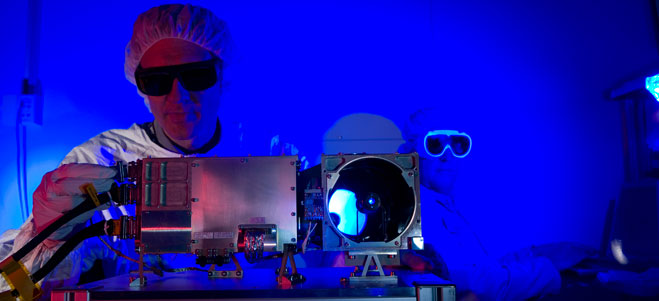ESTO-funded RTIMS memory module
Memory Module for Earth Science Applications to Support
Mars Science Laboratory, ChemCam Instrument
October 26, 2009 – Philip Larkin, NASA ESTO
![]()
The Earth Science Technology Office (ESTO)-funded Radiation Tolerant Intelligent Memory Stack (RTIMS), which was developed for Earth-observing missions at geostationary and low Earth orbit, has been chosen to support the Chemistry & Camera (ChemCam) instrument on board the Mars Science Laboratory (MSL), which is set to launch in the fall of 2011. The memory module features state-of-the-art chip stacking construction, radiation shielding, and radiation mitigation technologies.
On board MSL, RTIMS will control the firing of the ChemCam laser, data aquisition, data buffering, and communication with the Rover Compute Element. The ChemCam instrument will use a laser to vaporize materials up to 9 meters away on the surface and analyze the elemental composition of those materials. The laser will also be used to clear away dust from rocks in order to obtain detailed images.
RTIMS will help to safeguard ChemCam observations with novel radiation shielding and radiation mitigation technologies. RTIMS uses radiation shielding at the component level instead of system level to increase reliability. A self-scrubbing and event detection system, triple redundant digital memory, and in-flight-reconfigurability further improve radiation tolerance and allow RTIMS to overcome both hardware and software errors as well as adapt to changing mission conditions.
Built with a new chip stacking technology, RTIMS also provides a significantly smaller and lighter memory array than was previously available. The construction method allows a heterogeneous stack of electronic parts to be built into a single component – a reprogrammable FPGA, six synchronous dynamic random access memories, a linear regulator, and the radiation mitigation circuitries are stacked into a module of 42.7mm x 42.7mm x 13.0mm. This packaging process saves as much as 80% in the required volume or footprint.
MSL will likely be only one of several rides into space for the RTIMS technology. Astrium, a leading European aerospace company, is designing RTIMS into a communications satellite and evaluating it for other projects. 3D Plus Inc., a partner in the development of RTIMS, has also commercialized and sold the modules, which can be used for a variety of applications where radiation tolerant memory and computing are needed.
RTIMS was developed at NASA Langley Research Center with funding by the ESTO Advanced Information System Technologies (AIST) program.
Above Right: the unique stacking technology for RTIMS: 1) first layer of components added to the package,
2) remaining layers assembled, 3) pure epoxy resin molding, 4) nickel and gold plating, and
5) final tantalum shielding. (credit: Jeff Herath, Principal Investigator for the RTIMS project)
Below: The ChemCam Mast Unit being prepared for laser firing (credit: Los Alamos National Laboratory)

